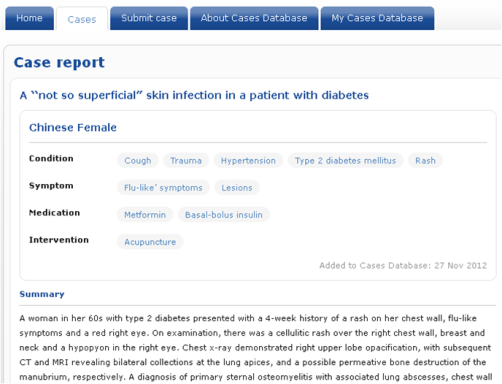David Spiegelhalter, a statistician at the University of Cambridge, has devised a novel way of weighing the benefits of one health resolution against another, using the concept of ‘microlives’. Instead of measuring habits such as red meat consumption in years lost from the average life, he calculates the effects of daily choices in small units of time, called microlives.
Spiegelhalter divided up the years remaining for a 35-year-old with a typical life span of 80 years into nearly a million 30-minute periods and defined each half-hour as one microlife. He then calculated how various habits may affect the microlives a person has left. more…
BioMed Central have launched a free Cases Database that allows clinicians, researchers, teachers and patients to explore peer-reviewed medical case reports from multiple journal publishers (including BMJ Group, BioMed Central and Springer). The database is freely accessible and contains 11627 cases from 100 different journals.
It is hoped that bringing together so many case reports will encourage the identification of trends and patterns, thereby providing researchers with hypotheses for further systematic research.
The database offers structured search and filtering by condition, symptom, intervention, pathogen, patient demographic and many other data fields, allowing fast identification of relevant case reports to support clinical practice and research.

more…
I’ve already blogged about RebelMouse, the self-proclaimed “social front page”, that pulls in user content from social sites like Facebook, Twitter and Instagram. Until it was created, social data had no central hub and tended to get drowned out and lost as soon as it was published. RebelMouse filled a gap in the market by providing one central location to capture a user’s online output. However, RebelMouse is no longer the only product in this space. Storify launched its redesign last week and many have commented on its similarities.

more…
BrainSpace, a potential solution to outdated search technology, was demonstrated at this year’s SpotOn London. Launched by PureDiscovery, a big data startup, its goal is to let users find information that matters without having to actually look for it. Instead, the technology is designed to bring data directly to the user.

BrainSpace is already well-established in the world of archived content; it powers semantic search across more than 350 million documents for LexisNexis. PureDiscovery, however, has set its sights much higher. By not only determining relationships between documents, but also between between people, and people and documents, it is gearing up to create a ‘social brain’ which will revolutionise search. more…
In a very popular ‘Assessing social media impact’ session at SpotOn London this week, a number of social media tools were discussed. Twentyfeet cropped up (mainly due to the visibility of its automated weekly updates on free accounts) along with Klout and PeerIndex, with varying degrees of enthusiasm from participants.
The most interesting take-away for me personally was an introduction to Crowdbooster. It’s a free tool that lets you pull together statistics for one Twitter and one Facebook account. (If you want to add multiple accounts, you’ll need to pay).

more…
The website Scribd describes itself as the “world’s largest online library, a place to read, publish, and share written documents.”
In March this year Peter Doshi, a post doctoral fellow at Johns Hopkins University, sent the BMJ a link to a page displaying corresondence with the US Food and Drug Administration, urging it to investigate CellTexTherapeutics Corporation and RNL Bio.
Doshi wondered if the BMJ might be interested in launching a similar online campaign as part of its drive to persuade drug companies to publish the full data from clinical trials. more…
In Copenhagen this week Richard Smith met Dr Twitter. In London I met Mr LinkedIn. Mark Williams (#mr_linkedin) describes himself as the UK’s leading independent LinkedIn trainer, helping individuals and organisations make the most of the professional network that now boasts 185m members worldwide, including 34,000 doctors at the last count. I went along to ask Williams, who was addressing an audience of publishers, why so many of my connections have started endorsing me lately. More about that later.
But first, some figures. Every second two people join LinkedIn, which was launched by Reid Hoffman in 2003 and is now a vibrant community where make connections, get business, undertake research, and join groups of likeminded professionals. More than half of its members live in the US. India is the second most popular country. It has 6m more members than the UK, but London is the most active city after San Francisco and New York, and Brazil is the fastest growing country. more…
Article-level metrics (or ALMs) were a hot topic at this week’s HighWire publisher meeting in Washington. (Highwire hosts both the BMJ and its stable of 42 specialist journals). From SAGE to eLife, publishers seem sold on the benefits of displaying additional context to articles, thereby enabling readers to assess their impact. These statistics range from traditional indicators, such as usage statistics and citations, to alternative values (or altmetrics) like mentions on Twitter and in the mainstream media.
So, what services are available to bring this information together in one simple interface? There are quite a few contenders in this area, including Plum Analytics, PLoS Article-Level Metrics application, Science Card, CitedIn and ReaderMeter. One system in particular has received a good deal of attention in the past few weeks; ImpactStory, a relaunched version of total-impact. It’s a free, open-source webapp that’s been built with financial help from the Sloan Foundation (and others) “to help researchers uncover data-driven stories about their broader impacts”.
 more…
more…
Posted in
altmetrics,
Apps,
Article metrics,
Article-level links,
Author services,
Authors,
Citations,
Facebook,
HighWire Press,
ISI Web of Science,
Scientific communication,
Social Bookmarking,
Social networking
Publishers face authorship issues on a daily basis. Who should be listed as an author? How can an author role be appropriately acknowledged? How can we discern author responsibility? Linked to this is conflict-of-interest reporting: who needs to report what, and in what context?
A registry that will grant scientists a unique identifying number, helping readers of the literature to distinguish between authors with similar names, launched this week. ORCID, the Open Researcher and Contributor ID, seeks to remedy the systemic name ambiguity problems seen in scholarly research by assigning unique identifiers linkable to an individual’s research output. more…
more…
Eighteen months ago a colleague and I were looking at the online and print BMJ with a view to discovering the ratio of UK to international content. At the time planned changes to both the NHS in England and the US healthcare system were generating a lot of news, comment, and debate.
Colleagues were spending increasing amounts of time in the US, India, and elsewhere, attending conferences and participating in workshops, yielding in rise in article submissions from these countries. This was helped in part by the decision to recruit a European research editor, based in the Netherlands, to complement a similar post based in the US. We also have an education editor based in Sydney. more…






